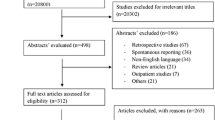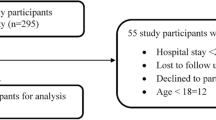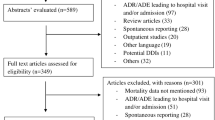Abstract
Purpose
Hospital mortality related to adverse drug reactions (ADRs) is a relevant clinical problem with major health and economic consequences. We conducted a study to assess hospital mortality related to ADRs, the drugs most frequently involved, and the possible risk factors associated with fatal ADRs.
Methods
A retrospective observational study was conducted, reviewing the clinical records of 1388 consecutive adult patients (18–101 years) who died during a 22-month period in a tertiary hospital in Southern Europe (Granada, Spain). The main outcome was the prevalence of hospital death suspected to be related to administered drugs.
Results
Out of the 1388 adult deaths studied, 256 (18.4 %) were suspected of being related to drugs. Drugs were suspected of causing death in 146 inpatients (10.5 %) and contributing to death in 110 (7.9 %). Drugs related to death were administered during the hospital stay in 161 cases (11.5 %) and before hospital admission in 95 (6.84 %). The most frequent fatal ADRs were cardiac arrhythmia, gastrointestinal bleeding, and respiratory failure. The drugs most frequently involved in fatal ADRs were antithrombotics (anticoagulants or antiplatelets) (23 %), psychotropic drugs (21.2 %), and digoxin (11.3 %). Independent risk factors for ADR-related death were the presence of ≥4 diseases (OR = 1.43) and the receipt of ≥10 drugs (OR = 3.24), but no significant association with gender or age was found.
Conclusions
A high percentage of hospital deaths were suspected of being associated with ADRs, especially in patients with comorbidity and/or polypharmacy. Antithrombotics, psychotropics, and digoxin were the drugs most frequently associated with in-hospital drug-related deaths.
Similar content being viewed by others

References
Boeker EB, de Boer M, Kiewiet JJ, Lie-A-Huen L, Dijkgraaf MG, Boermeester MA (2013) Occurrence and preventability of adverse drug events in surgical patients: a systematic review of literature. BMC Health Serv Res 13:364
Hug BL, Keohane C, Seger DL, Yoon C, Bates DW (2012) The costs of adverse drug events in community hospitals. Jt Comm J Qual Patient Saf 38:120–126
Kalisch Ellett LM, Pratt NL, Ramsay EN, Barratt JD, Roughead EE (2014) Multiple anticholinergic medication use and risk of hospital admission for confusion or dementia. J Am Geriatr Soc 62:1916–1922
Khan LM (2013) Comparative epidemiology of hospital-acquired adverse drug reactions in adults and children and their impact on cost and hospital stay—a systematic review. Eur J Clin Pharmacol 69:1985–1996
Leporini C, De Sarro G, Russo E (2014) Adherence to therapy and adverse drug reactions: is there a link? Expert Opin Drug Saf 13(Suppl 1):41–55
Blix HS, Viktil KK, Reikvam A, et al. (2004) The majority of hospitalised patients have drug-related problems: results from a prospective study in general hospitals. Eur J Clin Pharmacol 60:651–658
Davies EC, Green CF, Mottram DR, Pirmohamed M (2006) Adverse drug reactions in hospital in-patients: a pilot study. J Clin Pharm Ther 31:335–341
Davies EC, Green CF, Taylor S, Williamson PR, Mottram DR, Pirmohamed M (2009) Adverse drug reactions in hospital in-patients: a prospective analysis of 3695 patient-episodes. PLoS one 4:–e4439
Ebbesen J, Buajordet I, Erikssen J, et al. (2001) Drug-related deaths in a department of internal medicine. Arch Intern Med 161:2317–2323
Juntti-Patinen L, Neuvonen PJ (2002) Drug-related deaths in a university central hospital. Eur J Clin Pharmacol 58:479–482
Kelly WN (2001) Potential risks and prevention, part 1: fatal adverse drug events. Am J Health Syst Pharm 58:1317–1324
Lazarou J, Pomeranz BH, Corey PN (1998) Incidence of adverse drug reactions in hospitalized patients: a meta-analysis of prospective studies. JAMA 279:1200–1205
Moore TJ, Cohen MR, Furberg CD (2007) Serious adverse drug events reported to the Food and Drug Administration, 1998-2005. Arch Intern Med 167:1752–1759
Mouton JP, Mehta U, Parrish AG, et al. (2015) Mortality from adverse drug reactions in adult medical inpatients at four hospitals in South Africa: a cross-sectional survey. Br J Clin Pharmacol 80:818–826
Rivkin A (2007) Admissions to a medical intensive care unit related to adverse drug reactions. Am J Health Syst Pharm 64:1840–1843
Wester K, Jönsson AK, Spigset O, Druid H, Hägg S (2008) Incidence of fatal adverse drug reactions: a population based study. Br J Clin Pharmacol 65:573–579
Zoppi M, Braunschweig S, Kuenzi UP, Maibach R, Hoigné R (2000) Incidence of lethal adverse drug reactions in the comprehensive hospital drug monitoring, a 20-year survey, 1974-1993, based on the data of Berne/St. Gallen. Eur J Clin Pharmacol 56:427–430
Puche Cañas E, Luna Del Castillo JD (2007) Adverse drug reactions in patients visiting a general hospital: a meta-analysis of results. An Med Interna 24:574–578
Pardo Cabello AJ, González Contreras LG, Manzano Gamero MV, Gómez Jiménez FJ, Puche CE (2009) Prevalence of fatal adverse drug reactions in hospitalized patients. Int J Clin Pharmacol Ther 47:596–602
Wulff HR. Rational diagnosis and treatment. Oxford, England: Blackwell; 1981. Available at: http://sgh.org.sa/Portals/0/Articles/Rational%20Diagnosis%20and%20Treatment%20Evidence-Based-%20Clinical%20Decision-Making%20%283rd%20edition%29.pdf
World Health Organization. International Classification of Disease, 10th Edition (ICD-10). Geneve: World Health Organization 1992.
The Anatomical Therapeutic Chemical (ATC) classification system and the Defined Daily DosE (DDD) Index 2014, http://www.whocc.no/Accessed April 16, 2014.
Thürmann PA (2001) Methods and systems to detect adverse drug reactions in hospitals. Drug Saf 24:961–968
Lessing C, Schmitz A, Albers B, Schrappe M (2010) Impact of sample size on variation of adverse events and preventable adverse events: systematic review on epidemiology and contributing factors. Qual Saf Health Care 19:e24
Naranjo CA, Busto U, Sellers EM, et al. (1981) A method for estimating the probability of adverse drug reactions. Clin Pharmacol Ther 30:239–245
Wu CS, Tsai YT, Tsai HJ (2015) Antipsychotic drugs and the risk of ventricular arrhythmia and/or sudden cardiac death: a nation-wide case-crossover study. J Am Heart Assoc 4:e001568
van der Maarel-Wierink CD, Vanobbergen JN, Bronkhorst EM, Schols JM, de Baat C (2011) Risk factors for aspiration pneumonia in frail older people: a systematic literature review. J Am Med Dir Assoc 12:344–354
Zetin M (2004) Psychopharmacohazardology: major hazards of the new generation of psychotherapeutic drugs. Int J Clin Pract 58:58–68
Rathore SS, Wang Y, Krumholz HM (2002) Sex-based differences in the effect of digoxin for the treatment of heart failure. N Engl J Med 347:1403–1411
Madadi P, Hildebrandt D, Lauwers AE, Koren G (2013) Characteristics of opioid-users whose death was related to opioid-toxicity: a population-based study in Ontario, Canada. PLoS one 8:e60600
Woolcott JC, Richardson KJ, Wiens MO, et al. (2009) Meta-analysis of the impact of 9 medication classes on falls in elderly persons. Arch Intern Med 169:1952–1960
Dequito AB, Mol PG, van Doormaal JE, et al. (2011) Preventable and non-preventable adverse drug events in hospitalized patients: a prospective chart review in The Netherlands. Drug Saf 34:1089–1100
Zwart-van Rijkom JE, Uijtendaal EV, ten Berg MJ, van Solinge WW, Egberts AC (2009) Frequency and nature of drug-drug interactions in a Dutch university hospital. Br J Clin Pharmacol 68:187–193
Buajordet I, Ebbesen J, Erikssen J, Brørs O, Hilberg T (2001) Fatal adverse drug events: the paradox of drug treatment. J Intern Med 250:327–341
Morimoto T, Gandhi TK, Seger AC, Hsieh TC, Bates DW (2004) Adverse drug events and medication errors: detection and classification methods. Qual Saf Health Care 13:306–314
Lau HS, Florax C, Porsius AJ, De Boer A (2000) The completeness of medication histories in hospital medical records of patients admitted to general internal medicine wards. Br J Clin Pharmacol 49:597–603
Acknowledgments
The authors are grateful to Eloísa Casado Fernández MD and Carmen Laraño Díaz MD of the Clinical Documentation Department of San Cecilio University Hospital of Granada (Spain) and to Ana García Velasco and María Soriano Segura, research fellows of the School of Medicine of the University of Granada (Spain), for their participation in the gathering and coding of the data. The authors thank Richard Davies for improving the English style.
Authors contributions
Dr. AJ Pardo Cabello performed research, analyzed data and wrote the paper. Dr. E Del Pozo Gavilán performed research, analyzed data and wrote the paper. Dr. FJ Gómez Jiménez performed research, analyzed data and wrote the paper. Dr. C Mota Rodríguez performed research. Dr. JD Luna del Castillo analyzed data. Dr. E Puche Cañas conceived and designed study, performed research, analyzed data and wrote the paper.
Author information
Authors and Affiliations
Corresponding author
Ethics declarations
Ethical approval
All procedures performed in this study were in accordance with the ethical standards of the institutional research committee. Formal consent is not required for this retrospective study.
Funding
This study was funded by Department of Pharmacology (CP-2), University of Granada (Spain) in manuscript preparation.
Conflict of interest
The authors declare that they have no conflict of interest.
Electronic supplementary materials
ESM 1
(PDF 71.2 kb)
Rights and permissions
About this article
Cite this article
Pardo Cabello, A., Del Pozo Gavilán, E., Gómez Jiménez, F. et al. Drug-related mortality among inpatients: a retrospective observational study. Eur J Clin Pharmacol 72, 731–736 (2016). https://doi.org/10.1007/s00228-016-2026-0
Received:
Accepted:
Published:
Issue Date:
DOI: https://doi.org/10.1007/s00228-016-2026-0



